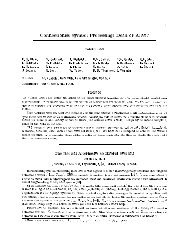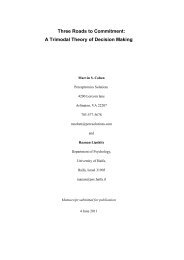Three Roads to Commitment: A Trimodal Theory of Decision Making
Three Roads to Commitment: A Trimodal Theory of Decision Making
Three Roads to Commitment: A Trimodal Theory of Decision Making
Create successful ePaper yourself
Turn your PDF publications into a flip-book with our unique Google optimized e-Paper software.
<strong>Three</strong> <strong>Roads</strong> <strong>to</strong> <strong>Commitment</strong>: A <strong>Trimodal</strong> <strong>Theory</strong> <strong>of</strong> <strong>Decision</strong> <strong>Making</strong> 19<br />
the desirability and likelihood <strong>of</strong> their future consequences, and selects the one that is best. The three modes rely on<br />
distinctive normative foundations, based on accepted practice (matching), variation and selective retention<br />
(reassessment), or coherence between actions, consequences, and desires (choice). 9<br />
-----------------------------------------------------------<br />
Insert Figure 1 about here<br />
-----------------------------------------------------------<br />
A newly generated, selected, or validated commitment has three possible fates, as shown by arrows emerging<br />
from One COA in the upper left quadrant <strong>of</strong> Figure 1. It may be acted on immediately; it may be tested and<br />
reassessed immediately; or it may remain as an intention until implementation – in the meantime framing further<br />
decision making and perhaps also subjected <strong>to</strong> reassessment. Moreover, in all cases <strong>of</strong> increased commitment,<br />
elements <strong>of</strong> the background frame that contributed <strong>to</strong> it become more connected, hence, more central <strong>to</strong> the web <strong>of</strong><br />
beliefs, goals, and actions; as a result, they are themselves more resistant <strong>to</strong> subsequent reassessment.<br />
The traditional s<strong>to</strong>ry <strong>of</strong> decision making conceals the fact that many, and probably most, decisions concentrate<br />
on the present situation (matching) or past performance (reassessment) rather than future consequences (choice).<br />
Given the systematic differences among the modes, and the functional priority <strong>of</strong> matching and reassessment, it is a<br />
mistake <strong>to</strong> dismiss these decisions as poor approximations <strong>to</strong> choice. The standard s<strong>to</strong>ry fails <strong>to</strong> explain where goals,<br />
situation frames, and options come from (matching); why choice and reassessment are sometimes not permitted<br />
(matching); and how learning and innovation take place (reassessment). In the next section, we look at relationships<br />
between TDM and a variety <strong>of</strong> naturalistic models.<br />
DECISION STRATEGIES AS PATHS TO COMMITMENT<br />
Cognitive strategies are well-travelled sets <strong>of</strong> paths through the framework outlined in Figure 1, <strong>of</strong>ten spanning<br />
multiple cycles in multiple modes and at different levels <strong>of</strong> specificity and scope. In this section, we exercise the<br />
9 A testable implication <strong>of</strong> TDM is that the distinctive features <strong>of</strong> each decision mode will co-vary. For example, an<br />
experiment might present the same decision problem <strong>to</strong> three groups <strong>of</strong> participants. The groups may be formed on<br />
the basis <strong>of</strong> prior proclivities for matching, choice, or reassessment, respectively; alternatively, they may be formed<br />
by priming with material emphasizing ethics, pr<strong>of</strong>it maximization, or flexibility and experimentation. The matching<br />
group would be expected <strong>to</strong> attend more <strong>to</strong> the situation and their role in it, and <strong>to</strong> justify decisions in terms <strong>of</strong><br />
appropriateness. The choice group should attend more <strong>to</strong> options and their outcomes, and justify decisions in terms<br />
<strong>of</strong> finding the best. The reassessment group should attend <strong>to</strong> recent testing <strong>of</strong> a course <strong>of</strong> action and ways <strong>to</strong> improve<br />
it, and justify decisions in terms <strong>of</strong> what works.




